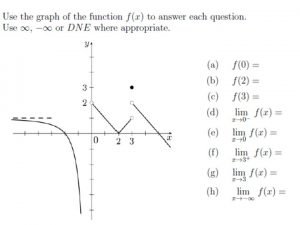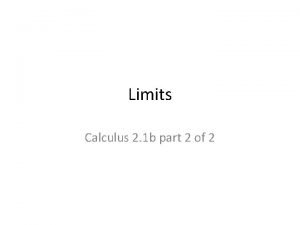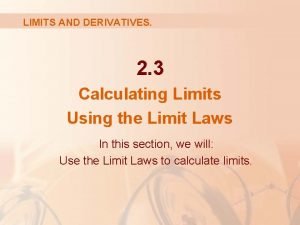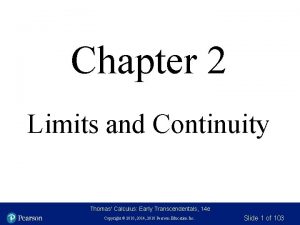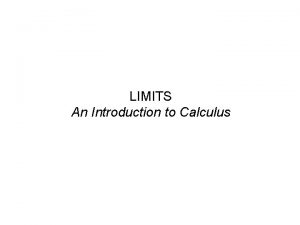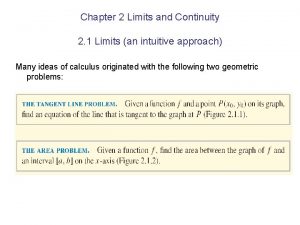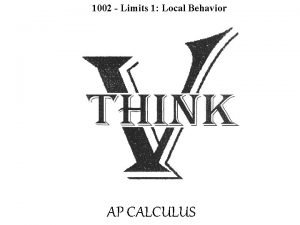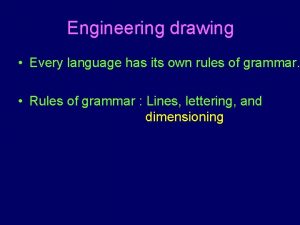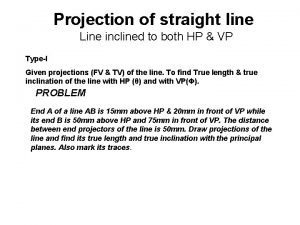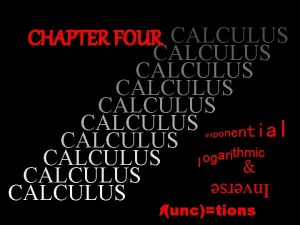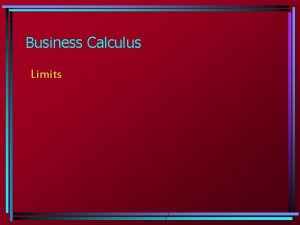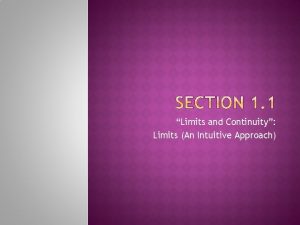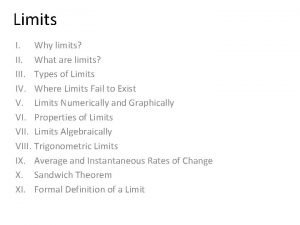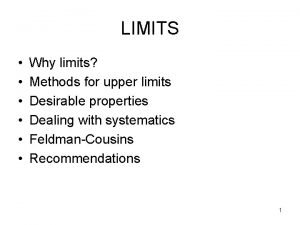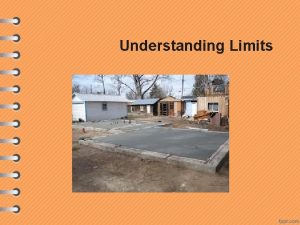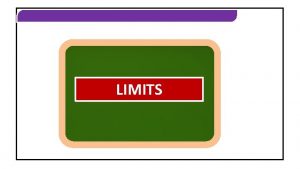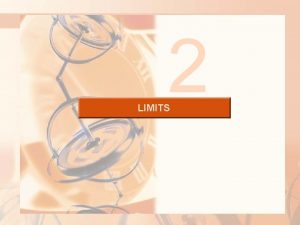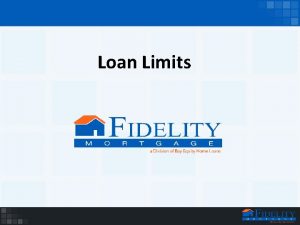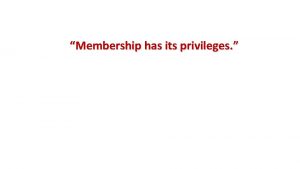LIMITS oh yeah Calculus has its limits AP



































![Example Limits [-6, 6] by [-10, 10] Example Limits [-6, 6] by [-10, 10]](https://slidetodoc.com/presentation_image_h2/74629f42b9037797138e2ad720b20174/image-36.jpg)
- Slides: 36

LIMITS … oh yeah, Calculus has its limits! AP CALCULUS MS. OLIFER

What you’ll learn about • Definition of Limit • Properties of Limits • One-Sided and Two-Sided Limits …and why Limits can be used to describe continuity, the derivative and the integral: the ideas giving the foundation of calculus.

Definition of Limit Example 1, pg. 69

Definition of Limit continued

Theorem 1 • For any constant k and c, Slide 2 - 5

One-Sided and Two-Sided Limits

One-Sided and Two-Sided Limits continued

Example One-Sided and Two-Sided Limits Find the following limits from the given graph. 4 o 1 2 3

Limits: A Numerical and Graphical Approach THEOREM: As x approaches a, the limit of f (x) is L, if the limit from the left exists and the limit from the right exists and both limits are L. That is, if 1) and 2) then

Limits: A Numerical and Graphical Approach Example 1: Consider the function H given by Graph the function, and find each of the following limits, if they exist. When necessary, state that the limit does not exist. a) b)

Limits: A Numerical and Graphical Approach a) Limit Numerically First, let x approach 1 from the left: H(x) 0 2 0. 5 3 Thus, it appears that 0. 8 3. 6 0. 9 3. 8 0. 99 3. 98 0. 999 3. 998

Limits: A Numerical and Graphical Approach a) Limit Numerically (continued) Then, let x approach 1 from the right: H(x) 2 0 1. 8 – 0. 4 Thus, it appears that 1. 1 – 1. 8 1. 01 1. 0001 – 1. 98 – 1. 9998

Limits: A Numerical and Graphical Approach a) Limit Numerically (concluded) Since 1) and 2) Then, does not exist.

Limits: A Numerical and Graphical Approach a) Limit Graphically Observe on the graph that: 1) and 2) Therefore, does not exist.

Limits: A Numerical and Graphical Approach b) Limit Numerically First, let x approach – 3 from the left: H(x) – 4 – 6 Thus, it appears that – 3. 5 – 3. 1 – 4. 2 – 3. 01 – 4. 02 – 3. 001 – 4. 002

Limits: A Numerical and Graphical Approach b) Limit Numerically (continued) Then, let x approach – 3 from the right: H(x) – 2 Thus, it appears that – 2. 5 – 3 – 2. 9 – 3. 8 – 2. 99 – 3. 98 – 2. 999 – 3. 998

Limits: A Numerical and Graphical Approach b) Limit Numerically (concluded) Since 1) and 2) Then,

Limits: A Numerical and Graphical Approach b) Limit Graphically Observe on the graph that: 1) and 2) Therefore,

Limits: A Numerical and Graphical Approach The “Wall” Method: As an alternative approach to Example 1, we can draw a “wall” at x = 1, as shown in blue on the following graphs. We then follow the curve from left to right with pencil until we hit the wall and mark the location with an × , assuming it can be determined. Then we follow the curve from right to left until we hit the wall and mark that location with an ×. If the locations are the same, we have a limit. Otherwise, the limit does not exist.

Limits: A Numerical and Graphical Approach Thus for Example 1: does not exist

Limits: A Numerical and Graphical Approach Example 3: Consider the function f given by Graph the function, and find each of the following limits, if they exist. If necessary, state that the limit does not exist. a) b)

Limits: A Numerical and Graphical Approach a) Limit Numerically Let x approach 3 from the left and right: f (x) 2. 1 13 2. 5 5 2. 99 3. 5 3. 2 3. 1 3. 01 f (x) Thus,

Limits: A Numerical and Graphical Approach a) Limit Graphically Observe on the graph that: 1) and 2) Therefore,

Limits: A Numerical and Graphical Approach b) Limit Numerically Let x approach 2 from the left and right: f (x) 1. 5 1 1. 9 – 7 1. 99 – 97 1. 999 – 997 f (x) 2. 5 5 2. 1 13 2. 01 103 2. 001 1003 Thus, does not exist.

Limits: A Numerical and Graphical Approach b) Limit Graphically Observe on the graph that: 1) and 2) Therefore, does not exist.

1. 1 Limits: A Numerical and Graphical Approach Example 4: Consider again the function f given by Find

Limits: A Numerical and Graphical Approach Limit Numerically Note that you can only approach ∞ from the left: 5 f (x) Thus, 10 1000 3. 125 3. 0102 3. 001

Limits: A Numerical and Graphical Approach Limit Graphically Observe on the graph that, again, you can only approach ∞ from the left. Therefore,

Properties of Limits

Properties of Limits continued Product Rule: Constant Multiple Rule:

Properties of Limits continued

Example Properties of Limits

Polynomial and Rational Functions

Example Limits

Example Limits
![Example Limits 6 6 by 10 10 Example Limits [-6, 6] by [-10, 10]](https://slidetodoc.com/presentation_image_h2/74629f42b9037797138e2ad720b20174/image-36.jpg)
Example Limits [-6, 6] by [-10, 10]
 I bet you
I bet you Solving limits algebraically
Solving limits algebraically Calculus 2 limits
Calculus 2 limits Limit laws
Limit laws Thomas calculus limits and continuity
Thomas calculus limits and continuity Calculus limits
Calculus limits Chapter 2 limits and continuity
Chapter 2 limits and continuity Calculus limits review
Calculus limits review Real limits
Real limits Lim as x approaches infinity
Lim as x approaches infinity Bickled
Bickled Ar verb conjugation
Ar verb conjugation Yeah host
Yeah host Yeah diagram
Yeah diagram War by edwin starr meaning
War by edwin starr meaning Yeah but i do
Yeah but i do Yeah but i do
Yeah but i do Examples of conclusion paragraphs
Examples of conclusion paragraphs Yeah david
Yeah david Its not easy but its worth it
Its not easy but its worth it Windy cloudy rainy sunny
Windy cloudy rainy sunny If its square its a sonnet summary
If its square its a sonnet summary The emigree annotations
The emigree annotations Its halloween its halloween the moon is full and bright
Its halloween its halloween the moon is full and bright When a train increases its velocity its momentum
When a train increases its velocity its momentum Weather tomorrow nnn
Weather tomorrow nnn A company has satisfied its performance obligation when the
A company has satisfied its performance obligation when the Every nation and every country
Every nation and every country A graphic language and has its own alphabet and grammar
A graphic language and has its own alphabet and grammar Every nation has _________ customs and traditions
Every nation has _________ customs and traditions Psychology has its roots in philosophy
Psychology has its roots in philosophy Progressive dimensioning
Progressive dimensioning Vray displacement edge length
Vray displacement edge length A ball rolling down an incline has its minimum speed
A ball rolling down an incline has its minimum speed A line is inclined to both hp & vp, its fv & tv will be
A line is inclined to both hp & vp, its fv & tv will be Each season has its own beauty
Each season has its own beauty Here in the power of christ i stand
Here in the power of christ i stand

